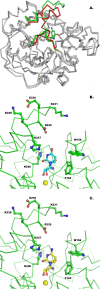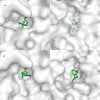Active site plasticity revealed from the structure of the enterobacterial N-ribohydrolase RihA bound to a competitive inhibitor
- PMID: 20529317
- PMCID: PMC2898832
- DOI: 10.1186/1472-6807-10-14
Active site plasticity revealed from the structure of the enterobacterial N-ribohydrolase RihA bound to a competitive inhibitor
Abstract
Background: Pyrimidine-preferring N-ribohydrolases (CU-NHs) are a class of Ca2+-dependent enzymes that catalyze the hydrolytic cleavage of the N-glycosidic bond in pyrimidine nucleosides. With the exception of few selected organisms, their physiological relevance in prokaryotes and eukaryotes is yet under investigation.
Results: Here, we report the first crystal structure of a CU-NH bound to a competitive inhibitor, the complex between the Escherichia coli enzyme RihA bound to 3, 4-diaminophenyl-iminoribitol (DAPIR) to a resolution of 2.1 A. The ligand can bind at the active site in two distinct orientations, and the stabilization of two flexible active site regions is pivotal to establish the interactions required for substrate discrimination and catalysis.
Conclusions: A comparison with the product-bound RihA structure allows a rationalization of the structural rearrangements required for an enzymatic catalytic cycle, highlighting a substrate-assisted cooperative motion, and suggesting a yet overlooked role of the conserved His82 residue in modulating product release. Differences in the structural features of the active sites in the two homologous CU-NHs RihA and RihB from E. coli provide a rationale for their fine differences in substrate specificity. These new findings hint at a possible role of CU-NHs in the breakdown of modified nucleosides derived from RNA molecules.
Figures






Similar articles
-
Structure, Oligomerization and Activity Modulation in N-Ribohydrolases.Int J Mol Sci. 2022 Feb 25;23(5):2576. doi: 10.3390/ijms23052576. Int J Mol Sci. 2022. PMID: 35269719 Free PMC article. Review.
-
New insights into the mechanism of nucleoside hydrolases from the crystal structure of the Escherichia coli YbeK protein bound to the reaction product.Biochemistry. 2006 Jan 24;45(3):773-82. doi: 10.1021/bi0511991. Biochemistry. 2006. PMID: 16411753
-
Energy landscapes associated with macromolecular conformational changes from endpoint structures.J Am Chem Soc. 2010 Dec 15;132(49):17570-7. doi: 10.1021/ja107640u. Epub 2010 Nov 17. J Am Chem Soc. 2010. PMID: 21082835
-
Computer simulations of trypanosomal nucleoside hydrolase: determination of the protonation state of the bound transition-state analogue.J Am Chem Soc. 2002 Jul 31;124(30):8825-33. doi: 10.1021/ja020312x. J Am Chem Soc. 2002. PMID: 12137535
-
The importance of nucleoside hydrolase enzyme (NH) in studies to treatment of Leishmania: A review.Chem Biol Interact. 2017 Feb 1;263:18-27. doi: 10.1016/j.cbi.2016.12.004. Epub 2016 Dec 8. Chem Biol Interact. 2017. PMID: 27939867 Review.
Cited by
-
Noncanonical calcium binding motif controls folding of HopQ1, a Pseudomonas syringae type III secretion effector, in a pH-dependent manner.Sci Rep. 2024 Dec 30;14(1):31796. doi: 10.1038/s41598-024-82848-z. Sci Rep. 2024. PMID: 39738557 Free PMC article.
-
Structure and function of nucleoside hydrolases from Physcomitrella patens and maize catalyzing the hydrolysis of purine, pyrimidine, and cytokinin ribosides.Plant Physiol. 2013 Dec;163(4):1568-83. doi: 10.1104/pp.113.228775. Epub 2013 Oct 29. Plant Physiol. 2013. PMID: 24170203 Free PMC article.
-
Ribonucleoside Hydrolases-Structure, Functions, Physiological Role and Practical Uses.Biomolecules. 2023 Sep 12;13(9):1375. doi: 10.3390/biom13091375. Biomolecules. 2023. PMID: 37759775 Free PMC article. Review.
-
Structure, Oligomerization and Activity Modulation in N-Ribohydrolases.Int J Mol Sci. 2022 Feb 25;23(5):2576. doi: 10.3390/ijms23052576. Int J Mol Sci. 2022. PMID: 35269719 Free PMC article. Review.
References
Publication types
MeSH terms
Substances
LinkOut - more resources
Full Text Sources
Molecular Biology Databases
Miscellaneous

